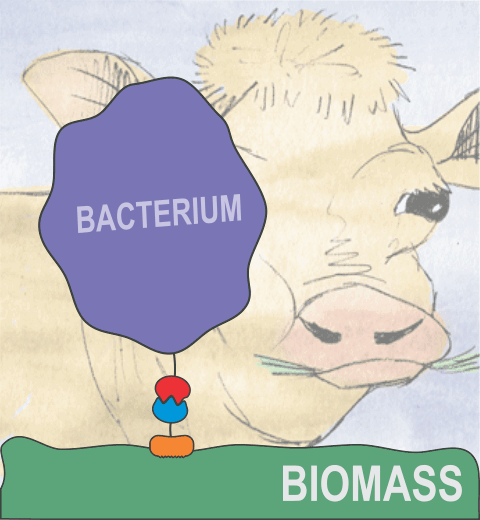Symbiont Bacteria
Bacterial communities within the human body greatly influence human health and play a significant role in diseas e predisposition, pathogenic, physical fitness, and dietary responsiveness. Importantly, bacteria utilize highly co operative macromolecular machines to accomplish many cellular functions. Here we seek to understand, with molecular and atomistic fidelity, two such machines: the cellulosome and the chemosensory array, which underlie the phenomen a of bacterial plant fiber degradation and chemotaxis respectively.
Biofuels: Bacteria can make a living off a very wide range of food sources. This agnosticism enables them to, among other things, serve as essential symbionts in animal digestive tracts where they assist their hosts in d egrading cellulose fibers into metabolizable compounds. In particular, bacteria in the rumen of the cow face an esp ecially tough job (see Tight Job in the Gut), digesting the hardy cellulose fibers of grasses. Key to their task are molecular tentacles on the cell s urface of certain gut bacteria, so-called cellulosomes (pictured right), which develop a tight grasp on cellulose a nd then effectively cleave the molecules. In general, human gut bacteria (and their role in the broader human micro biome) are one of the most intensely researched topics in medicine.
Bacterial Chemotaxis: Bacteria monitor their environments and respond by way of a fundamental sensory cap ability known as chemotaxis---one of the best studied behavioral systems in biology. Chemotactic responses in bacte ria involve large complexes of sensory proteins, known as chemosensory arrays, that process the information obtaine d from the bacteria's habitat to determine its swimming pattern. In this sense, the chemosensory array functions as a bacterial brain, transforming sensory input into motile output. Despite great strides in the understanding of ho w the chemosensory array's constituent proteins fit and work together, a high-resolution description has, until rec ently, remained elusive (see Computing the Bacterial Brain). Here we are combining computational and experimental techniques to explore in detail the molecular mechanisms underlying sensory signal transduction and amplification within this amazing biological appar atus.
Spotlight: Tight Job in the Gut (Feb 2015)
Bacteria can make a living from a very wide range of food sources. This ability makes them, for example, essential symbionts in animal digestive tracts where they assist their hosts in breaking cellulose fibers up into compounds degradable by the animal metabolism. Today, human gut bacteria, part of the human microbiome, are one of the hottest research topics in medicine. Gut bacteria face a particularly tough job in the rumen of the cow where they digest hardy cellulose fibers of grasses. Key to the job, taking place in a constantly moving fluid, are molecular tentacles, so-called cellulosomes, on the surface of the symbiotic bacteria. The cellulosomes develop a tight grasp on and then effective cleavage of cellulose. In a joint experimental-computational study researchers have investigated how in case of the bacterium Ruminococcus flavefaciens cellulosomes are built in a modular way, with molecular modules easily binding and unbinding during cellulosome construction, but sticking extremely strongly together during cellulosome digestive activity. As reported recently, single molecule force microscopy and molecular dynamics simulations using NAMD could show that under strain the adhesive bonds between cellulosome modules become stronger than seen in any other biomolecular system, in fact, become nearly as tight as strong chemical bonds. While the experimental data revealed bond strength and other characteristics, simulations reproducing the observed data provided a detailed view of the adhesive bond at atomic resolution, thereby revealing the physical mechanism underlying the uniquely adhesive property of cellulosomes. Gut bacteria and cellulosomes can be employed in 2nd generation biofuel generation (see highlight Waste into Fuel). More on gut bacteria and cellulosomes on our biofuels website.




